It looks like you're using an Ad Blocker.
Please white-list or disable AboveTopSecret.com in your ad-blocking tool.
Thank you.
Some features of ATS will be disabled while you continue to use an ad-blocker.
28
share:
I believe it's possible to establish the function of the Puma Punku complex from an ostensibly earlier site of the formative period at
Chiripa of Initial Period/Early Horizon, from 1400 to 850 Bc, this lay between Tiwanaku and Lake
Titicaca.
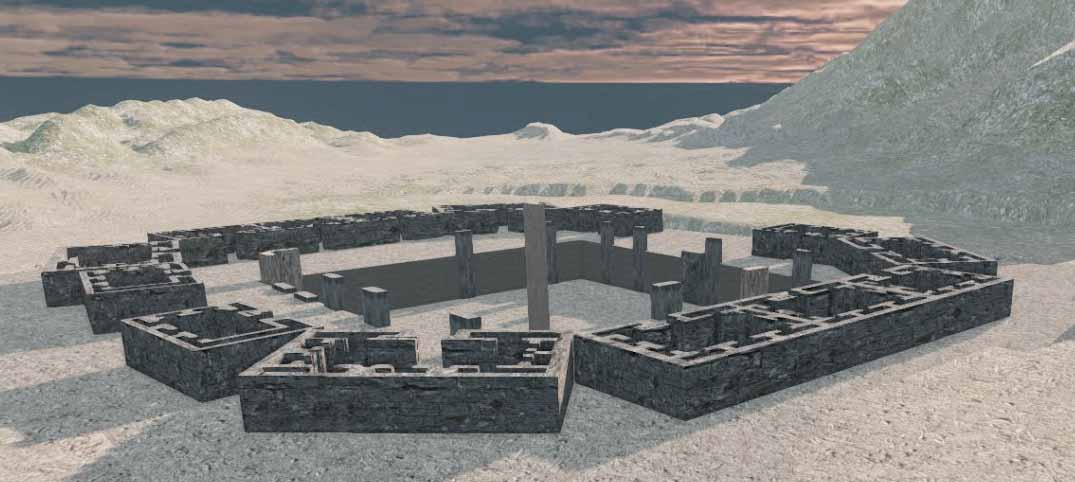
The site went through several stages of variations on a theme;
This is the earliest basis for such sacred architecture in the Andean region and it would either be the case that the Puma Punku complex was a more highly developed example of this at a later date, or that commencing at 1,500 BC this is actually a poor mans version of an already ruined Puma Punku complex, either way there are intriguing features at Chiripa.
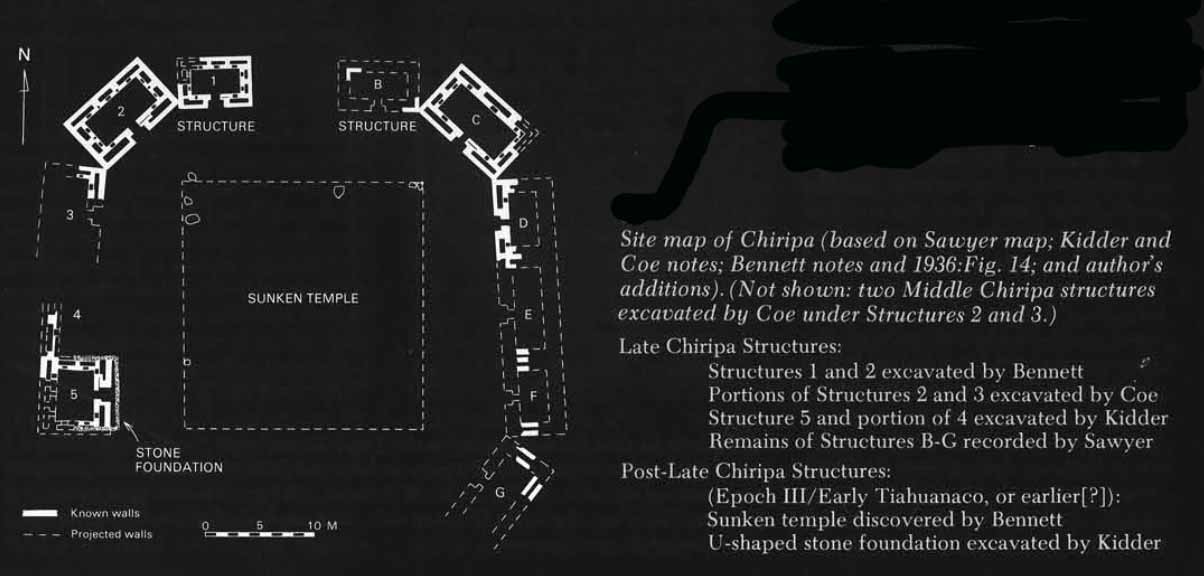
The buildings around the central sunken courtyard or possibly pool are essentially storage facilities, there are grooves cut into the door jambs to facilitate both upper and sliding door panels, inside the facility are nine compartmentalized storage areas, again with grooves set into the windowed compartments that would slide open and could then be resealed.
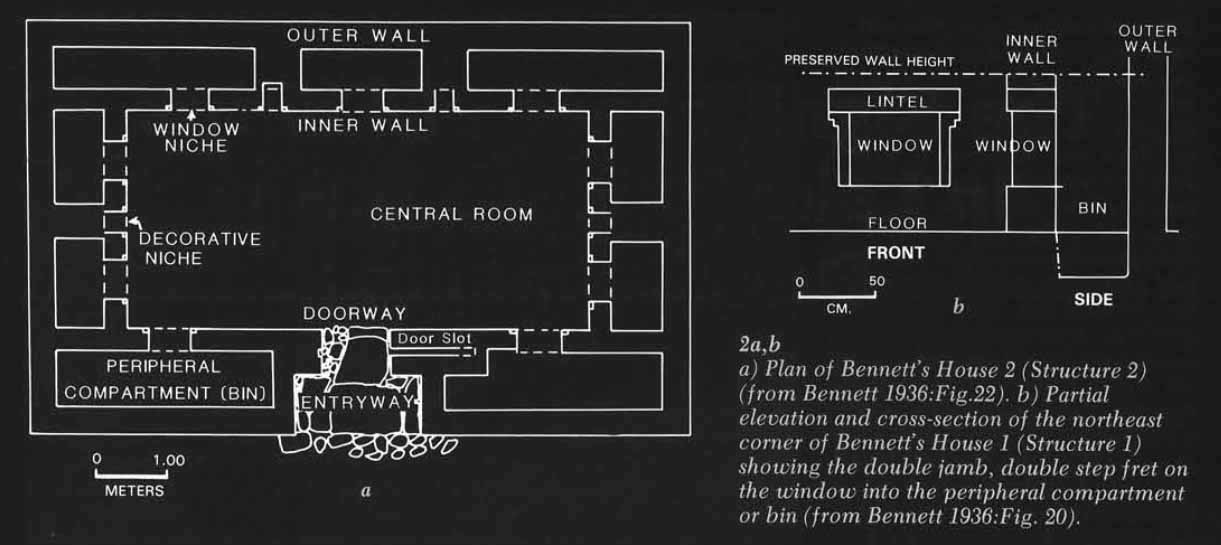
The architectural design of the windowed compartments is reminiscent of Puma Punku and thus one has certainly influenced the other, it's always been the case with Puma Punku that a function needed to be determined for all the curious grooves and insets of the stones, Chiripa provides really the only comparable basis in the greater region, and sliding doors and compartments is a pretty cool feature for formative period Andean architecture.

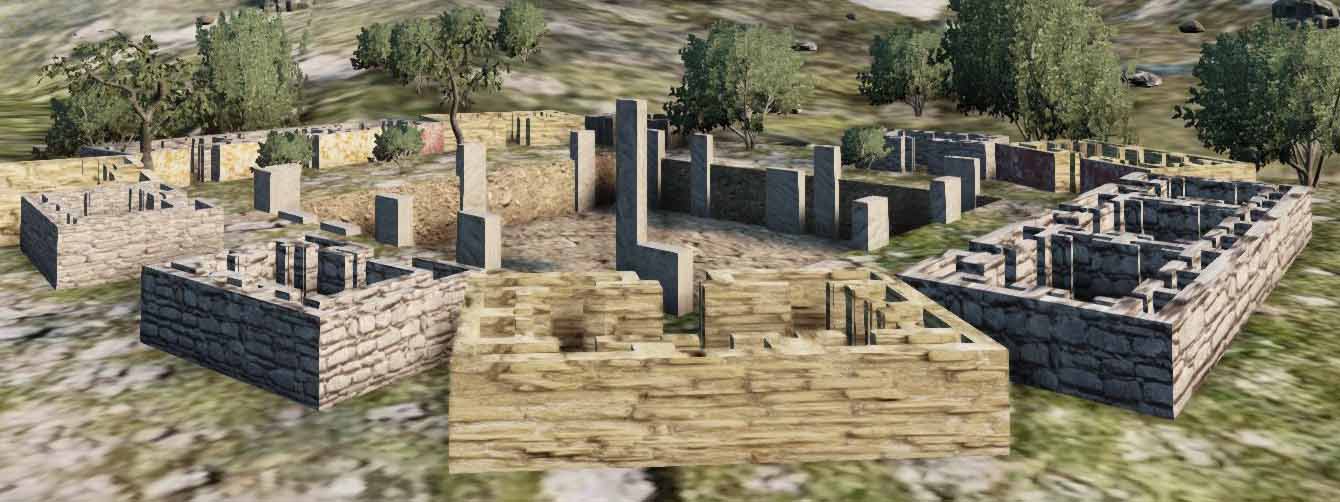
The function of the complex then was essentially storage, there is some evidence of agricultural produce within the storage compartments remaining and these were the people to whom we owe the development of the potato and a wide variety of crops are evidenced from the site, the centre then perhaps also functioning as an agricultural development centre, this principle is also found recorded in early Mesopotamian texts were the Temple complexes could be understood as seed banks from which all living things emerged, no small purpose involved there.
It was also the case that this site had far ranging trade contacts at an early date, importing minerals and resources from as far away as 300 km, as well as the skeletal remains of birds found only in the tropical regions at the site, the limestone used in construction was brought in from 30 km away, so they were a well organized and connected community.
New Light on Andean Tiwanaku
The Significance of Chiripa
Introduction to Chiripa site area
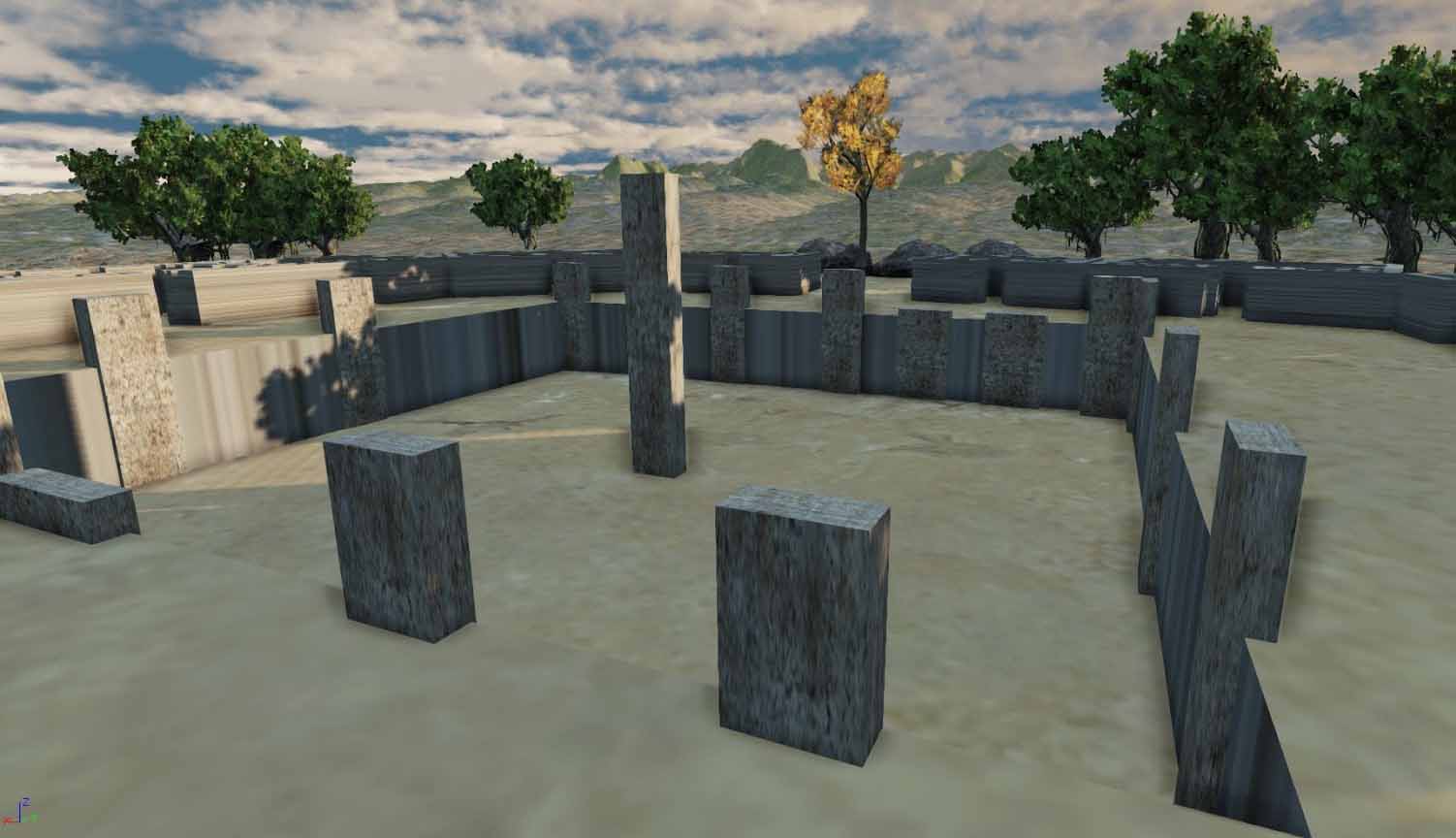

The site went through several stages of variations on a theme;
The site of Chiripa consists of a large mound platform that dominates the settlement. On the platform is a rectangular sunken plaza with a carved stone in the center of the plaza. Rituals occurred in specially prepared public places like the plaza suggesting the importance of rituals in the creation and maintenance of legitimacy and power
This is the earliest basis for such sacred architecture in the Andean region and it would either be the case that the Puma Punku complex was a more highly developed example of this at a later date, or that commencing at 1,500 BC this is actually a poor mans version of an already ruined Puma Punku complex, either way there are intriguing features at Chiripa.

The buildings around the central sunken courtyard or possibly pool are essentially storage facilities, there are grooves cut into the door jambs to facilitate both upper and sliding door panels, inside the facility are nine compartmentalized storage areas, again with grooves set into the windowed compartments that would slide open and could then be resealed.

The architectural design of the windowed compartments is reminiscent of Puma Punku and thus one has certainly influenced the other, it's always been the case with Puma Punku that a function needed to be determined for all the curious grooves and insets of the stones, Chiripa provides really the only comparable basis in the greater region, and sliding doors and compartments is a pretty cool feature for formative period Andean architecture.


The function of the complex then was essentially storage, there is some evidence of agricultural produce within the storage compartments remaining and these were the people to whom we owe the development of the potato and a wide variety of crops are evidenced from the site, the centre then perhaps also functioning as an agricultural development centre, this principle is also found recorded in early Mesopotamian texts were the Temple complexes could be understood as seed banks from which all living things emerged, no small purpose involved there.
It was also the case that this site had far ranging trade contacts at an early date, importing minerals and resources from as far away as 300 km, as well as the skeletal remains of birds found only in the tropical regions at the site, the limestone used in construction was brought in from 30 km away, so they were a well organized and connected community.
New Light on Andean Tiwanaku
The Significance of Chiripa
Introduction to Chiripa site area

a reply to: Kantzveldt
Interesting thread, it would indeed be great if we could determine the function of Puma Punku.
Based on the above it would have been a ritualistic, perhaps religious one (plus rooms for storage)? I haven't read all the links yet and haven't heard of Chiripa before, but could water have been involved in the layout in any functional way? When looking at the remains of PP there were also a few aquaduct-like elements among the many blocks.
As for the sunken platform there does seem to be a parallel here to the small-scale model found at PP:

Nice find, S&F!
Interesting thread, it would indeed be great if we could determine the function of Puma Punku.
Based on the above it would have been a ritualistic, perhaps religious one (plus rooms for storage)? I haven't read all the links yet and haven't heard of Chiripa before, but could water have been involved in the layout in any functional way? When looking at the remains of PP there were also a few aquaduct-like elements among the many blocks.
As for the sunken platform there does seem to be a parallel here to the small-scale model found at PP:

Nice find, S&F!
edit on 1-7-2017 by jeep3r because: text
originally posted by: jeep3r
a reply to: Kantzveldt
Interesting thread, it would indeed be great if we could determine the function of Puma Punku.
Based on the above it would have been a ritualistic, perhaps religious one (plus rooms for storage)? I haven't read all the links yet and haven't heard of Chiripa before, but could water have been involved in the layout in any functional way? When looking at the remains of PP there were also a few aquaduct-like elements among the many blocks.
As for the sunken platform there does seem to be a parallel here to the small-scale model found at PP:
Nice find, S&F!
That looks like it used to be a bathing pool. The square holes are for feet dips, the larger pool is for swimming in.
I wonder why the stone at the end is missing. Did somebody want to drain it?
a reply to: jeep3r
Certainly in Mesopotamia religious function was combined with the practical and agricultural, Temple complexes as cattle breeding centres and seed depositories and nurseries, a celebration of creation and the generation and sustenance of life in conjunction with appropriate Deities, i think that would have been the case at Chiripa.
If Puma Punku is a classical development of those ideals it would carry through the same ideals and practises, however if as some consider the complex is actually older then Chiripa is emulating that former establishment, i have some sympathy with this viewpoint as the Andesite blocks can be seen as scavenged in Tiwanaku satellite colonies to provide the first layer of small Temple buildings which are then finished off in wattle and daub, they don't appear to have the means to consistently construct and create such blocks.
The central courtyard could have been a pool with the central monolith relating to the act of singular first creation from the waters, it could also have been used as a fish pond in keeping with the theme of the practical and the sacred.
The many storage compartments created couldn't have been for high volume storage, perhaps seeds and produce related to specific Deities or even storage of sacred artifacts related to them.
Certainly in Mesopotamia religious function was combined with the practical and agricultural, Temple complexes as cattle breeding centres and seed depositories and nurseries, a celebration of creation and the generation and sustenance of life in conjunction with appropriate Deities, i think that would have been the case at Chiripa.
If Puma Punku is a classical development of those ideals it would carry through the same ideals and practises, however if as some consider the complex is actually older then Chiripa is emulating that former establishment, i have some sympathy with this viewpoint as the Andesite blocks can be seen as scavenged in Tiwanaku satellite colonies to provide the first layer of small Temple buildings which are then finished off in wattle and daub, they don't appear to have the means to consistently construct and create such blocks.
The central courtyard could have been a pool with the central monolith relating to the act of singular first creation from the waters, it could also have been used as a fish pond in keeping with the theme of the practical and the sacred.
The many storage compartments created couldn't have been for high volume storage, perhaps seeds and produce related to specific Deities or even storage of sacred artifacts related to them.
It would be amazing if we were all wrong that they just built it cause they were bored.
I always love your threads Kantz nice to see you again
I always love your threads Kantz nice to see you again
Fascinating thread. Has anyone done astrological studies on the site? Is it possible the inner courtyard also served as a sacred calendar to mark the
seasons? Reading the initial description the small rooms with doors sounded exactly like granaries. Perhaps this was storage for strains of grain that
were experimental and grown nearby, given the small size it would be impractical for mass agriculture as much more seed would be required.
I do think that water was an important element to the design of this and Puma Punku. Given the high, arid plateau they were situated on water would have been scarce and given special consideration. Being part of their creation myths as well I could hardly imagine a sacred site without water as part of it's purpose and design.
I do think that water was an important element to the design of this and Puma Punku. Given the high, arid plateau they were situated on water would have been scarce and given special consideration. Being part of their creation myths as well I could hardly imagine a sacred site without water as part of it's purpose and design.
edit on 1-7-2017 by Asktheanimals because: (no reason given)
a reply to: Brotherman
No excuse for being bored in a Centralized Creation Complex, just take a few dinosaur eggs out of storage...
No excuse for being bored in a Centralized Creation Complex, just take a few dinosaur eggs out of storage...
It was a resort and Casino for the people. Nice pool. The Indians are just carrying on their ancient tradition with their Casinos.
a reply to: Asktheanimals
It's maybe possible if you take the central monolith as a gnomon and perhaps the outer pillars of the court as indicating the solstice and equinox points for example.
It's maybe possible if you take the central monolith as a gnomon and perhaps the outer pillars of the court as indicating the solstice and equinox points for example.
originally posted by: Kantzveldt
a reply to: Asktheanimals
It's maybe possible if you take the central monolith as a gnomon and perhaps the outer pillars of the court as indicating the solstice and equinox points for example.
But why sink it into the ground in the first place? It looks like something you might see at a harbour port. But why no steps into the central area. If they used it as a pen for animals (breeding, experiments, religious purpose), would they be able to keep many animals?
originally posted by: Kantzveldt
a reply to: stormcell
The site will have some sort of cosmological premise, the overall complex in relationship to the central gnomon.
Good example of one of the ruined rooms from that site also.
Chiripa
Now that does make me think of a square clock face, a Buddhist monastry, a sundial/gnomon or a combination of all three.
if you could, can you find out about the site underneath the landmark tomb of the unknown soldier in Baghdad? There is a guard station on top, and a
museum underneath the station. Underneath the whole thing is a real tomb, I have been there before while working in Iraq but I cannot find anything
about that. You know much more about these places and things
Either way I'd still get you a drink
Either way I'd still get you a drink
new topics
-
We need less laws in the UK not more
General Chit Chat: 1 hours ago -
The Baloney aka BS Detection Kit
Social Issues and Civil Unrest: 6 hours ago -
Suspected Iranian agent working for Pentagon while U.S. coordinated defense of Israel
US Political Madness: 7 hours ago -
How does my computer know
Education and Media: 9 hours ago
top topics
-
Suspected Iranian agent working for Pentagon while U.S. coordinated defense of Israel
US Political Madness: 7 hours ago, 12 flags -
USO 10 miles west of caladesi island, Clearwater beach Florida
Aliens and UFOs: 14 hours ago, 9 flags -
The Baloney aka BS Detection Kit
Social Issues and Civil Unrest: 6 hours ago, 5 flags -
How does my computer know
Education and Media: 9 hours ago, 2 flags -
We need less laws in the UK not more
General Chit Chat: 1 hours ago, 0 flags
active topics
-
Afterlife, unknown, so prepare, or just go into the unknown (bad)!!
ATS Skunk Works • 54 • : Kennyb75 -
-@TH3WH17ERABB17- -Q- ---TIME TO SHOW THE WORLD--- -Part- --44--
Dissecting Disinformation • 478 • : cherokeetroy -
Suspected Iranian agent working for Pentagon while U.S. coordinated defense of Israel
US Political Madness • 14 • : YourFaceAgain -
Israel ufo shoot down drones?
Aliens and UFOs • 21 • : Asher47 -
Are the 'Abrahamic Religions' all Really the Worshipping the Same Abrahamic God?
Conspiracies in Religions • 176 • : FlyersFan -
Running Through Idiot Protestors Who Block The Road
Rant • 57 • : FlyersFan -
It has begun... Iran begins attack on Israel, launches tons of drones towards the country
World War Three • 642 • : CriticalStinker -
Tesla cutting 14,000 jobs
Global Meltdown • 49 • : Vermilion -
NYAG Letitia James Prepares to Begin Seizing TRUMP Assets Even Though There Was No Crime.
Above Politics • 277 • : matafuchs -
Abortions in first 12 weeks should be legalised in Germany, commission says
Medical Issues & Conspiracies • 13 • : malte86
28


